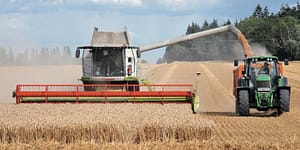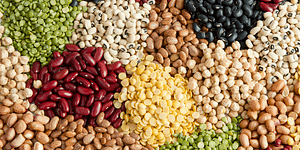What Does a Sustainable Future Look Like?

In a time of looming uncertainties, what would a truly resilient society look like? Farmer and social scientist Chris Smaje argues that organizing society around small-scale farming offers the soundest, most sustainable, and most reasonable response to climate change and other crises of civilization—and will yield humanity’s best chance at survival.
The following excerpt is from A Small Farm Future by Chris Smaje. It has been adapted for the web.
Let me start that journey with my feet on my farm. When people visit it I notice three main responses. One is an unbidden enthusiasm for the rural paradise we’ve created, the beauty of the place, and our great good fortune in avoiding the rat race and producing honest food from the land. Sometimes the words are spoken and sometimes I only see it in their eyes, but the sentiment that usually accompanies it is: ‘This is great. I wish I could do something like this, but I can’t because—’
The second response takes in our rustic accommodation, the compost toilets, the rows of hard-won vegetable beds, the toolshed speaking of the work to be done, the reek of manure and compost with a kind of recoiling pity. It seems to say: ‘You went to graduate school and got a well-paid job. Then this. How did it go so wrong?’ Or the more actively disdainful: ‘Each to their own. But nobody wants to farm any more. All that backbreaking work!’
The third response is that of the harsher critic, whose gaze homes in on specifics – the tractor in the yard, the photovoltaic panels on the roof, the tilled beds in some of the gardens. ‘Look how tied in you are to the global fossil fuel economy and its cash nexus.’ This critique comes from both sides of the green divide. ‘You haven’t properly escaped and found a truly natural way of life,’ from one side. ‘You talk about sustainability, but you’re no better than the rest of us. Besides, small farms like this can’t feed the world,’ from the other.
I begin with this story because I’m going to be arguing not only that, yes, small farms like this can feed the world, but also that in the long run it may only be small farms like this that can. Therefore I’m going to have to address the other criticisms – the compromises with the status quo, the low prestige and toil associated with an agrarian life, the global flight from the land. So I have a lot of work to do in these pages. One thing that encourages me is that, of the three responses I mentioned above, the first seems much the commonest – it simply isn’t true that nobody wants to farm.

Of course, it’s only a place to start, and a sketchy one at that. Notions of the agrarian good life are commonplace around the world, but often they figure as little more than bucolic symbols, empty of pragmatic content. They seem to lack the power of the urban case for supremacy, which has deep historic roots. City, citizenship, civilisation, civility: so much that we value about our world shares an urban etymology.
But if we want to build good lives on lasting foundations for the future, the time has come to abandon the unilluminating oppositions of city versus country and factory versus farm, as well as associated oppositions like progress versus backwardness.
Regrettably, that’s not how public debate seems to be going. There’s a veritable industry of opinion-formers laying their bets only on the first half of those dualities and exhorting us to be ‘optimistic’ about a future presented as urban, capital forming, high-tech and non-agrarian. This neo-optimist or progress-literature often invokes recurrent myths of human technological problem-solving as an inspiration for transcending present problems. Take, for example, London’s Great Horse Manure Crisis in the 1890s, where it’s said that people feared the proliferation of horses would bury the streets under their faeces, only to find horses were soon displaced by non-defecating motor vehicles. Or take the idea that fossil fuels saved the whales when kerosene-burning lamps displaced demand for whale oil.1
I call these myths partly in the everyday sense that they’re untrue. There never was a Great Horse Manure Crisis in the 1890s. And it was the industrialised whaling of the 20th century powered by fossil fuels that really put whales in danger.2 But they’re also myths in the deeper sense that they’re mystifying and over-simplifying stories that reveal cultural self-conceptions. The self-conception of our modern culture that’s revealed in these myths is that the problems we face are discrete, technical ones with one-shot solutions.
These stories are mystifying because they tell tales of fossil fuel–based solutions to predicaments in the past at a point in our current history when fossil fuels present us with problems for which there are no obvious solutions. Right now, we need more than banal assertions that someone’s bound to think of something. And they’re over-simplifying because human capacities for technical innovation aren’t in doubt. What’s in doubt is the human capacity to find purely technical solutions for a plethora of current economic, political, cultural, ecological, biological and geophysical problems with complex, interrelated feedback loops exhibiting imperfect information in real time.
In this book I try to provide a different narrative that’s less impressed with techno-fixes or dominant notions of civilisational progress. I don’t deny that our contemporary civilisation has its successes. But it has its failures, too. I see it in the eyes of those visitors to my farm – who in material terms must surely count among the richest people in the world, ever – which betray a life diminished, trammelled by too many of the wrong kind of obligations. More importantly, I see it in the fact that the world we live in today is just about the most unequal one ever, where somewhere between 800 million and 2.5 billion people are physically undernourished, about as many (or more) than the estimated 800 million population of the entire planet in 1750 at the dawn of the modern age.3

The better future I write about here is a small farm future. I’m not completely optimistic that it’s the future we or our descendants will see, but for the numerous reasons set out in the book I think it’s our best shot for creating future societies that are tolerably sustainable in ecological terms and fulfilling in nutritional and psychosocial ones. Now is a key moment in global politics where we might start delivering that future, but also where more troubling outcomes threaten. Here I try to herald the former by sketching what a small farm future might look like, and how we might get there.
The small farm isn’t a panacea, but what a politics geared around it can offer – what, perhaps, at least some of the visitors who come to our farm can glimpse in outline – is the possibility of personal autonomy, spiritual fulfilment, community connectedness, purposeful work and ecological conviviality. Relatively few farmers past or present have enjoyed these fine things. Throughout the world, there are long and complex histories by which people have been both yoked unwillingly to the land and divested unwillingly from it in ways that are misrepresented when we talk of agricultural ‘improvement’ or progressive ‘freedom’ from agricultural toil. The improvements haven’t been an improvement for everyone, the freedom hasn’t been equally shared, the progress has landed us in a whole raft of other problems that we must now try to overcome. And none of it was preordained.
That’s why it’s urgent at this point in history to think afresh about a small farm future. Taking each of the three words in reverse order, we need to think about the future, because it’s clear that present ways of doing politics, economics and agriculture in much of the world are reaching the end of the line. Wise authors avoid speculating on future events because time usually makes their words look foolish, but such dignity isn’t a luxury our generation can afford.
We need to start imagining another world into being right now.
Modern thinkers have coined numerous terms for the way we now live to distinguish it from the past: the affluent society, the effluent society, industrial society, post-industrial society, Industria, consumer society, postmodern society, the information society, the virtual society. These all capture something significant about our times, but they too easily allow us to forget that in fact our modern societies are agrarian societies, just like almost all other human societies over the past few thousand years. Humanity today relies heavily on just three crops – wheat, rice and maize – all of which had been domesticated by about 7000 BCE and which are still mostly grown using techniques whose basic outlines would be instantly recognisable to any ancient farmer. Despite the recent hype over industrially cultured nutrients, the future we face is probably a farm future.4

Whether individually we farm or not, almost all of us ultimately are farming people. In fact, there are more farmers in the world today by formal definition – somewhere between 1.5 and 2 billion – than at almost any point in history.6 There are good farmers and bad farmers. The best ones learn to produce what’s needed with a minimum of effort, without compromising the possibilities of their successors doing the same or losing sight of their obligations as members of communities. It’s about time we started trying to tell the story of our world from their perspective – not a story of how we transcended agriculture, because we never did, but of how we might transfigure it, and ourselves in the process, to deal with the problems we now face.
References:
- See, for example, Bastani 2019; Browne, John (2019) ‘Should We Pursue Boundless Economic Growth?’ Prospect, 30.
- Francis 1990; Gosho et al. 1984; Wild, Rose (2018) ‘We Were Buried in Fake News as Long Ago as 1894,’ The Times, 13 January.
- FAO n.d.; Hickel 2017; Holt-Giménez 2019; Milanovic 2016; UNICEF (2018) ‘The State of Food Security and Nutrition in the World 2018,’ https://data.unicef.org/resources/sofi-2018/.
- See Morrison, Oliver (2020) ‘“Cultured Meat Is Fool’s Gold”: Environmentalists Lock Horns over Controversial Documentary,’ Food navigator.com, 10 January.
- FAO n.d.; Smil 2017.
- ILO n.d.; Rosset and Altieri 2017.
Recommended Reads
Recent Articles
Oxeye daisies are one of the most important plants for pollinators including beetles, ants, and moths that use oxeye daisies as a source of pollen and nectar. Instead of thinking about removing a plant like oxeye daisy, consider how you can improve the fertility and diversity of habitat resources in your home landscape, garden, or…
Read MoreThis long-lived perennial legume is used for forage and erosion control. Kudzu is edible with many medicinal uses and other applications. Pollinators of all kinds love its prodigious lavender blooms!
Read MoreMove aside, maple! We have two new syrups to add to the table. Read on for insights on tapping, selling, and eating syrup from walnut & birch trees.
Read MoreWhy is modern wheat making us sick? That’s the question posed by author Eli Rogosa in Restoring Heritage Grains. Wheat is the most widely grown crop on our planet, yet industrial breeders have transformed this ancient staff of life into a commodity of yield and profit—witness the increase in gluten intolerance and ‘wheat belly’. Modern…
Read MoreDid you ever wonder how leeks, kale, asparagus, beans, squash, and corn have ended up on our plates? Well, so did Adam Alexander, otherwise known as The Seed Detective. The following is an excerpt from the The Seed Detective by Adam Alexander. It has been adapted for the web. My Seed-Detective Mission Crammed into two…
Read More








